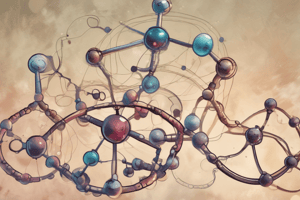Podcast
Questions and Answers
Reduction-Oxidation reactions (REDOX reactions) involve the gain and loss of electrons.
Reduction-Oxidation reactions (REDOX reactions) involve the gain and loss of electrons.
True (A)
What method do we use to balance REDOX reactions?
What method do we use to balance REDOX reactions?
half-reactions method
What happens during oxidation?
What happens during oxidation?
- Loss of electrons (correct)
- Neutralization
- Gain of electrons
- No change in electrons
What happens during reduction?
What happens during reduction?
In the same reaction K (s) + Br2 (l) → KBr (aq), what species is reduced?
In the same reaction K (s) + Br2 (l) → KBr (aq), what species is reduced?
The oxidation half-reaction for K is K0 → K+ + ______
The oxidation half-reaction for K is K0 → K+ + ______
In the reaction K (s) + Br2 (l) → KBr (aq), what species is oxidized?
In the reaction K (s) + Br2 (l) → KBr (aq), what species is oxidized?
The reduction half-reaction for Br2 is Br20 + ______ → 2Br¯
The reduction half-reaction for Br2 is Br20 + ______ → 2Br¯
What is the balanced overall reaction for 2K (s) + Br2 (l)?
What is the balanced overall reaction for 2K (s) + Br2 (l)?
Are Au3+ + I¯ → Au + I2 a REDOX reaction?
Are Au3+ + I¯ → Au + I2 a REDOX reaction?
Are Cu + Ag+ → Cu2+ + Ag a REDOX reaction?
Are Cu + Ag+ → Cu2+ + Ag a REDOX reaction?
Is BaSO3 → BaO + SO2 a REDOX reaction?
Is BaSO3 → BaO + SO2 a REDOX reaction?
In an acidic solution, which species in the reaction ClO3¯ + I2 → IO3¯ + Cl¯ is being oxidized?
In an acidic solution, which species in the reaction ClO3¯ + I2 → IO3¯ + Cl¯ is being oxidized?
In the same reaction ClO3¯ + I2 → IO3¯ + Cl¯, which species is being reduced?
In the same reaction ClO3¯ + I2 → IO3¯ + Cl¯, which species is being reduced?
Flashcards are hidden until you start studying
Study Notes
REDOX Reactions Overview
- REDOX reactions involve the transfer of electrons between species, where one species is oxidized (loses electrons) and another is reduced (gains electrons).
- Charge conservation is maintained through simultaneous oxidation and reduction.
- Assigning oxidation numbers is crucial for identifying oxidized and reduced species.
Key Definitions
- Oxidation: Loss of electrons, increasing positive charge.
- Reduction: Gain of electrons, increasing negative charge.
Balancing REDOX Reactions
- Use the half-reactions method for balancing.
- Identify oxidation and reduction half-reactions separately.
Example Problem: Balancing K + Br2 → KBr
- Assign oxidation numbers:
- K: 0 (elemental state) to +1 (in KBr).
- Br2: 0 to -1 (in KBr).
- Oxidation half-reaction: K → K⁺ + e⁻
- Reduction half-reaction: Br2 + 2e⁻ → 2Br⁻
- Balance charges by adding electrons to the appropriate sides:
- Oxidation: K → K⁺ + e⁻
- Reduction: Br2 + 2e⁻ → 2Br⁻
- Multiply the oxidation half-reaction by 2 to equalize electrons:
- 2K → 2K⁺ + 2e⁻
- Combine half-reactions, cancelling out electrons:
- 2K + Br2 → 2K⁺ + 2Br⁻
- Balanced equation: 2K (s) + Br2 (l) → 2KBr (aq)
Practice REDOX Reactions
- Confirm if a reaction is a REDOX reaction and balance it using the half-reaction method:
- Au³⁺ + I⁻ → Au + I2
- Cu + Ag⁺ → Cu²⁺ + Ag
- BaSO3 → BaO + SO2
Complex REDOX Reactions
- In aqueous solutions, especially in acidic or basic conditions, protons (H⁺) and hydroxides (OH⁻) play a significant role in balancing charges and species in half-reactions.
- Example in acidic solution:
- ClO3⁻ + I2 → IO3⁻ + Cl⁻
- Assign oxidation numbers to ascertain which species are oxidized and reduced before balancing.
Studying That Suits You
Use AI to generate personalized quizzes and flashcards to suit your learning preferences.




